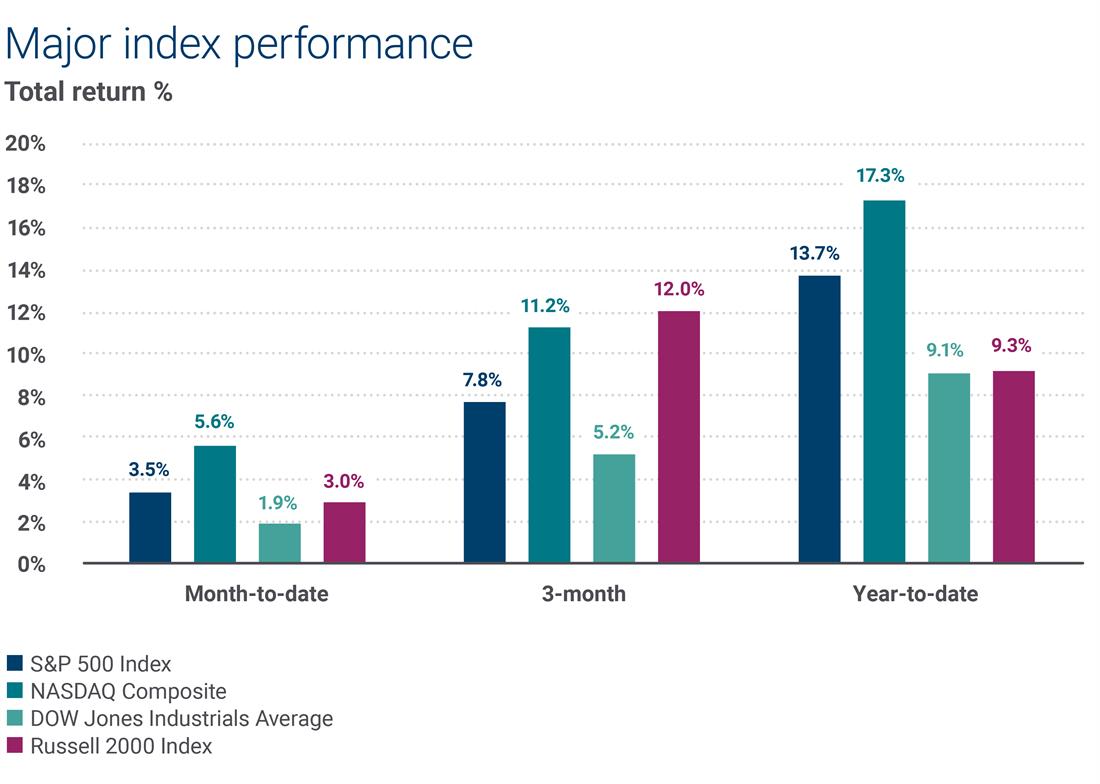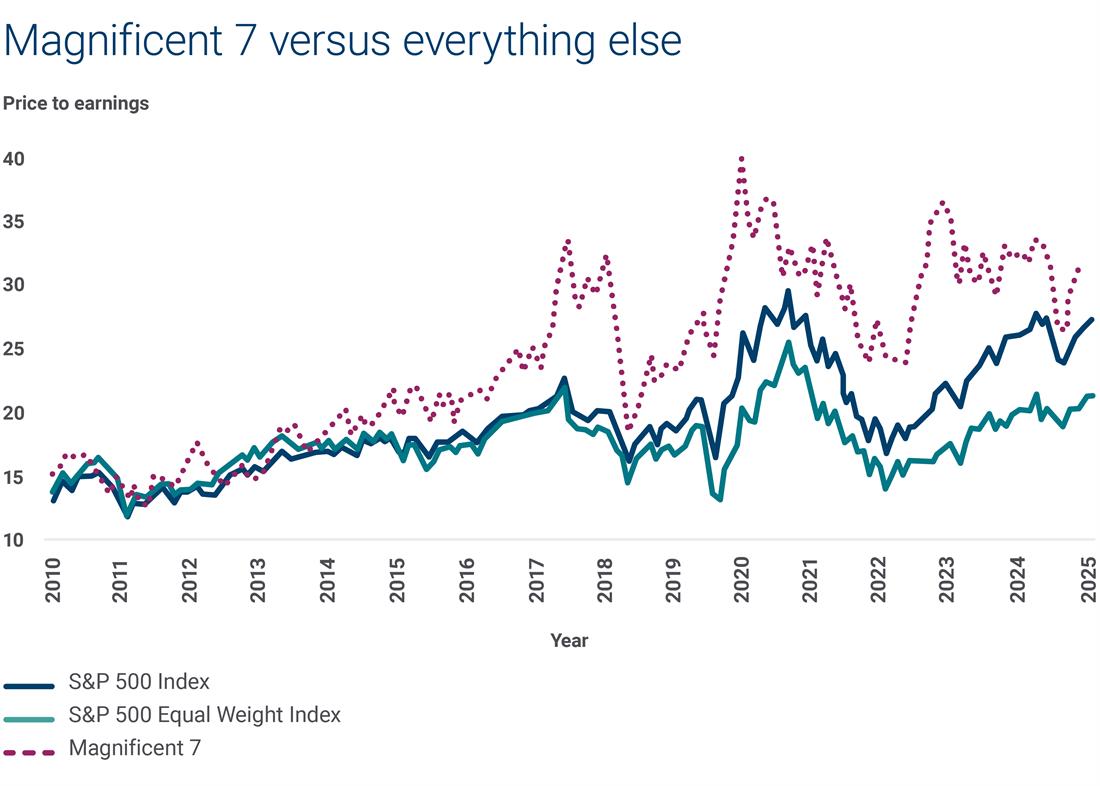Anthony Saglimbene, Chief Market Strategist – Ameriprise Financial
10/20/2025

The third quarter of 2025 delivered strong equity market performance, with broad-based gains across all major U.S. stock indices. The S&P 500 Index rose +7.8%, the NASDAQ Composite advanced +11.2%, the Dow Jones Industrial Average added +5.2% and the Russell 2000 Index climbed an impressive +12.0%, reflecting a notable pickup in small-cap momentum.
All in all, the months of July, August and September were particularly strong for U.S. markets – especially considering that this time of year is historically weak for stocks. Can the market carry this momentum into the final months of the year?
Here’s our Q4 2025 market outlook:
Q4 2025 outlook: The impact of interest rate cuts
As we enter the final quarter of 2025, Ameriprise Financial experts break down recent market and economic developments, including recent interest rate cuts. Get their projections on where the market may be headed in this episode of Ameriprise Talks. (9:20)
A look back at Q3: What drove stocks to all-time highs?

Sources: FactSet, American Enterprise Investment Services, Inc. Data as of 9/30/2025. These figures are shown for illustrative purposes only and are not guaranteed. An index is a statistical composite that is not managed. It is not possible to invest directly in an index. Past performance is not a guarantee of future results.
In our view, returns across domestic equities were supported by a combination of solid earnings, stable macroeconomic conditions and easing Federal Reserve (Fed) policy. Here’s an overview of how these factors influenced the overall investment landscape, helping to lift stocks in Q3:
- Interest rate cuts: Notably, the Fed's 25-basis-point rate reduction in September (the first since December 2024) marked a shift in restrictive policy stance. Still, commentary from officials since the previous meeting has remained mixed, keeping investors focused on the "pace" of future rate cuts rather than the direction of future moves.
- Stable macroeconomic conditions: Importantly, U.S. economic data remained generally constructive in Q3. We project the U.S. economy grew by +2.8% in the third quarter, driven by a strong consumer and manageable tariff impacts. Nevertheless, job creation slowed, and previous months of nonfarm payroll gains saw significant downward revisions. However, the unemployment rate remained steady through much of the quarter, and weekly jobless claims improved from midsummer levels.
- Steady consumer trends: While inflation was elevated and persistent in Q3, consumer trends remained steady, particularly in spending and income measures. In addition, surveys around retail indicated continued interest among consumers for big-ticket purchases. That said, lower-income households showed increased caution throughout the previous quarter, which could be a growing concern if higher-income households, which currently support roughly half of U.S. consumer spending today, decide to pull back.
- Strong corporate earnings: S&P 500 Q2 profit results beat expectations by a wide margin, and management teams signaled continued momentum into Q3, with analyst earnings estimates rising throughout the previous quarter. Q3 S&P 500 earnings per share (EPS) are expected to grow, possibly +8.0% year-over-year, with Information Technology projected to deliver another impressive quarter of results, potentially rising by over +20% year-over-year.
A return to Fed rate cuts: What it means for your money
How might interest rate cuts impact your investments and financial position? Read our interest rate outlook to learn more.
Learn more
A look ahead at Q4: Can 2025 finish strong?
As we head into the final quarter of the year, investors will want to watch the following dynamics closely:
- Elevated stock valuations present a risk for investors. The S&P 500's forward price-to-earnings ratio is approaching levels rarely seen in history, leaving less room to weather downside surprises, in our view.

Sources: FactSet, American Enterprise Investment Services, Inc. data as of 9/30/2025. These figures are shown for illustrative purposes only.
- Tariff effects may finally settle in. Q3 was marked by new tariff announcements, pauses, legal challenges and new trade deals with key allies. However, these developments were largely discounted by investors and markets due to the lack of broadly visible impacts in Q3.
In Q4, the stew of complexity around trade and current legal challenges could keep risks elevated. For example, tariff-exposed companies are facing a diminishing ability to pass on rising costs, and mitigation strategies could be tested the longer elevated tariffs remain in place. Notably, the Supreme Court is expected to hear oral arguments on the presidential administration's reciprocal tariffs in early November and could issue a decision on its legal merits by the end of the year.
- Investors are taking a harder look at AI spending. Within Big Tech, particularly among AI leaders, investors are increasingly scrutinizing capital expenditures and monetization timelines, despite sentiment toward AI's long-term earnings potential remaining positive.
- Overall sentiment entering Q4 is constructive but not euphoric. This could keep stocks biased to the upside over the next few months if fundamental conditions remain on a solid foundation.
In Q3, a broader swath of investors felt comfortable allocating more dollars to stocks, and corporate M&A activity provided additional tailwinds, conditions that could persist in Q4. However, a level of caution remains among consumers/investors regarding inflation stickiness, softer labor market trends, and the pace of future Fed rate cuts, which could create periods of volatility in Q4, depending on how conditions evolve.
- Solid seasonality factors in Q4 favor continued stock gains. According to Bespoke Investment Group, when the S&P 500 is higher year-to-date through the end of Q3 (+14.8% in 2025), Q4 has averaged a +4.4% gain, with positive returns roughly 83% of the time, going back to 1928. Since 1990, the average Q4 gain is +6.1% when the Index enters the final quarter of the year in positive territory, finishing the fourth quarter positive 88.5% of the time.
- With already stretched valuations, companies will likely need to deliver on elevated profit expectations to drive stocks higher through year-end. Notably, the third quarter earnings season could be critical in setting the tone for the remainder of the year, particularly for Big Tech, which has carried market leadership and momentum higher since the April lows.
- Macroeconomic risks should be closely watched. While macroeconomic fundamentals remain supportive, any deterioration in labor trends or rise in inflation during the fourth quarter that challenges investors' mostly sanguine view of the future could push back on what is historically the stock market's best three-month period of the year.
How should investors approach Q4?
In our view, U.S. markets enter Q4 with momentum, but the bar for further gains is high. Discipline and being selective are essential to navigating the final months of 2025.
Specifically, investors should consider maintaining diversified portfolios, emphasizing high-quality assets, funds and strategies exposed to companies with durable cash flows and clear competitive advantages.
Within the technology sector, investors' focus should remain on firms with proven AI monetization strategies and the ability to grow recurring revenue streams. Policy and trade developments remain wildcards, and volatility should be viewed as an opportunity to add to quality holdings should equities see periods of stress.
Connect with your advisor in Q4
The final months of the year are a smart time to review your financial situation and make strategic adjustments that could benefit your overall position. Connect with your Ameriprise financial advisor – they can make personalized recommendations to your overall investment strategy and identify smart financial actions to take before the year-end.